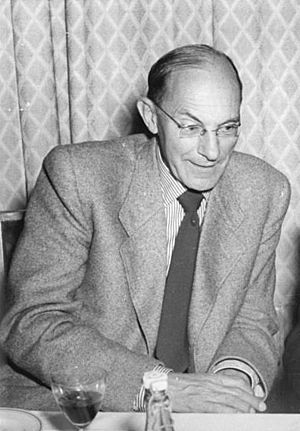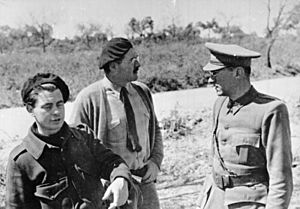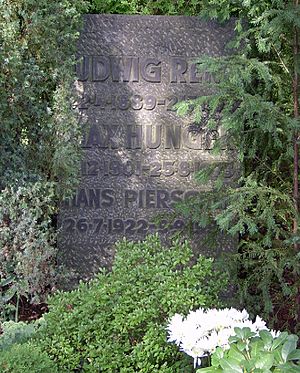Ludwig Renn facts for kids
Quick facts for kids
Ludwig Renn
|
|
|---|---|

Ludwig Renn in 1954
|
|
| Born |
Arnold Friedrich Vieth von Golßenau
22 April 1889 Dresden, German Empire
|
| Died | 21 July 1979 (aged 90) East Berlin, Germany
|
| Nationality | German |
| Occupation | Author |
Ludwig Renn was a German writer. He was born on April 22, 1889, with the name Arnold Friedrich Vieth von Golßenau. He passed away on July 21, 1979. Ludwig Renn came from a noble family in Saxony, Germany. Later in his life, he became a strong believer in communism and lived in East Berlin.
Contents
Early Life and World War I
Ludwig Renn was born Arnold Friedrich Vieth von Golßenau. His family was noble, meaning they had a high social rank. Their family home was in a place called Golßen. In 1930, he changed his name to Ludwig Renn. He did this after becoming a communist and giving up his noble title. He chose the name of the main character from his first successful book, Krieg (War).
His mother, Bertha, was the daughter of a chemist from Moscow. His father, Carl Johann Vieth von Golßenau, taught math and physics. He taught at the Royal Court of Saxony in Dresden. Through his father, Ludwig Renn met Prince Friedrich August Georg von Sachsen. This prince later became King Friedrich August III, the last King of Saxony.
From 1911, Renn served as an officer in a special Saxon army group. He served under his friend, Prince Friedrich August. Between 1914 and 1918, he fought in World War I. He was a leader for soldiers on the Western Front. His first book, Krieg (War), came out in 1928. It was about his experiences and became very popular.
After the war, he worked as a captain in the Dresden security police. This was a police-like group set up during the Weimar Republic. In 1920, during an event called the Kapp Putsch, Renn refused to shoot at workers who were protesting. He left the police soon after. He wrote about this in his book Nachkrieg (After War).
Studies and Travels
From 1920 to 1923, Renn went to universities in Göttingen and Munich. He studied law, economics, art history, and the Russian language. In 1923, he worked as an art dealer in Dresden. This was a time when money in Germany was losing its value very quickly.
In 1925 and 1926, Renn traveled on foot through parts of Europe and the Middle East. In 1927, he studied more about history and art in Vienna. He returned to Germany that same year. He gave talks to workers about the history of China and Russia. In Vienna in 1927, he saw police attack and kill many socialist protesters. After this, he became interested in left-wing ideas and eventually became a communist.
Becoming a Communist Writer and Soldier
In 1928, the same year his book Krieg was published, Renn joined the German Communist Party. His book Nachkrieg (1930) talks about this change. He also joined a group called the ‘Alliance of Red Front-Fighters’. From 1928 to 1932, he was a secretary for a writers' group in Berlin. Renn also edited communist newspapers. His work brought him close to other famous writers like Anna Seghers.
Renn's interest in communism grew. He traveled to the USSR in 1929 and 1930. He started to face problems from the National Socialists, also known as Nazis. So, in 1930, he gave up his noble title and took the name Ludwig Renn. Between 1931 and 1932, he taught about war history in Berlin. His books Nachkrieg (1930) and Rußlandfahrten (1932) made him a very important German communist writer.
In 1933, after the Reichstag fire, new laws were made that helped Adolf Hitler gain power. Renn was arrested in January 1934, along with others. He was sentenced to 30 months in prison but served 18 months.

After being released from prison in August 1935, he went to Spain. In July 1936, he joined the International Brigades. These were groups of volunteers who supported the Spanish Republican side in the Spanish Civil War. He became a chief officer for a group called the XI International Brigade.
In November 1936, he was in Madrid, writing training guides for the army. He was later moved out of the city for safety. He became a leader of the Thälmann Battalion and fought in important battles in 1937. In July 1937, he attended a meeting for writers to discuss the war. Many famous writers were there, including Ernest Hemingway. Renn spent time with Hemingway during his service in Spain.
He wrote about his time in Spain in his book Der spanische Krieg (1955). However, he could not mention Hemingway by name. This was because of rules in GDR at the time.
Exile and Return to Germany
After the Spanish Republicans lost the war, Renn went to France. Then, he went to Mexico, where he lived from 1939 to 1947. In Mexico, he was the president of a group called the Free Germany movement. During this time, he supported the use of Esperanto, a language created to be international.
In 1947, he came back to Germany. He settled in Dresden, which was then part of the Soviet area. From 1949, this area became East Germany. He worked as a director and a professor at the Dresden Technical University until 1951.
From 1952, Renn lived in East Berlin. He worked as a writer and was a member of the German Academy of the Arts. He also translated books from Spanish to German.
Why Ludwig Renn Was Important
Renn was one of the first writers to create a new type of literature in Germany. This literature focused on the lives of working-class people. His most important works were his books, which were often about his own life. They helped show what life was like during the difficult times he lived through.
His book Krieg was a big success around the world. In this book, Renn was one of the first to show the harsh reality of war for regular soldiers. Even though Renn was an officer, the book showed the experiences of a simple soldier. His next book, Nachkrieg (1930), showed the same character living in a time of political conflict after the war. This character grew to believe more in socialist ideas.
Renn wrote directly about his life in books like Adel im Untergang (1947). His last book, published after he passed away in 1980, was his autobiography. Besides novels and travel stories, Renn also wrote imaginative books for children and young people.
Private Life
When Renn returned from Mexico in 1947, he first lived in Dresden with his partner Max Hunger. In 1949, Hans Pierschel joined them. In 1952, the three men moved to Berlin-Kaulsdorf. They lived together there for the rest of their lives. After Renn's death, he was cremated. He was honored with a special grave in Berlin's Friedrichsfelde Cemetery. Hunger and Pierschel are buried in the same grave with Renn.
Works
- Krieg. (War.) 1928.
- In vorderster Linie. Aus der Aisne-Champagne-Schlacht 1917. (On the Front Line. From the Aisne-Champagne Battle 1917.) 1929.
- Nachkrieg. (After War.) 1930.
- Russlandfahrten. (Journeys to Russia.) 1932.
- Vor großen Wandlungen. (Before Great Changes.) 1936.
- Adel im Untergang. (Nobility in Decline.) 1944.
- Morelia. Eine Universitätsstadt in Mexiko. (Morelia. A University City in Mexico.) 1950.
- Vom alten und neuen Rumänien. (About Old and New Romania.) 1952.
- Trini. Die Geschichte eines Indianerjungen. (Trini. The Story of an Indian Boy.) 1954.
- Der spanische Krieg. (The Spanish War.) 1955.
- Der Neger Nobi. (Nobi the Negro.) (Children's book) 1955. Later titled Nobi.
- Herniu und der blinde Asni. (Herniu and Blind Asni.) 1956.
- Krieg ohne Schlacht. (War Without Battle.) 1957.
- Meine Kindheit und Jugend. (My Childhood and Youth.) 1957.
- Herniu und Armin. (Herniu and Armin.) 1958.
- Auf den Trümmern des Kaiserreiches. (On the Ruins of the Empire.) 1961.
- Camilo. (Children's book) 1963.
- Inflation. 1963.
- Zu Fuss zum Orient. (On Foot to the Orient.) 1966.
- Ausweg. (Way Out.) 1967.
- Krieger, Landsknecht und Soldat. (Warrior, Mercenary, and Soldier.) With Helmut Schnitter, Children's book. 1973.
- In Mexiko. (In Mexico.) 1979.
- Anstöße in meinem Leben. (Impulses in My Life.) 1980, published after his death.
Works in English
- War. 1929.
- After War. 1931.
- Death without Battle. 1937.
- Warfare. The Relation of War to Society. 1939.
Awards and Honors
- Awards for his children's books from the Ministry of Culture of the GDR.
- 1955: National Prize of the GDR Second Class.
- 1961: National Prize of the GDR First Class.
- 1969: Karl Marx Order.
- 1979: Grand Star of People's Friendship in Gold. This was given to him for his 90th birthday.
- 1969–1975: Honorary President of the Academy of Arts, Berlin.
|
See also
 In Spanish: Ludwig Renn para niños
In Spanish: Ludwig Renn para niños
- Exilliteratur


